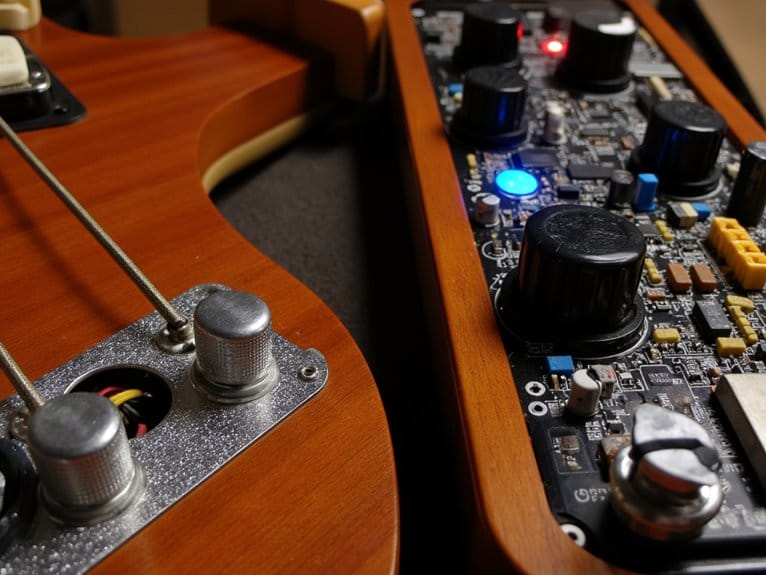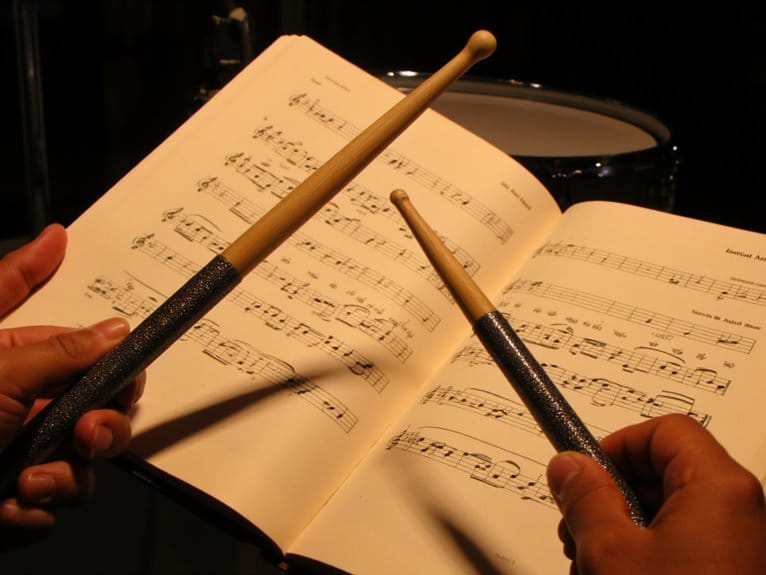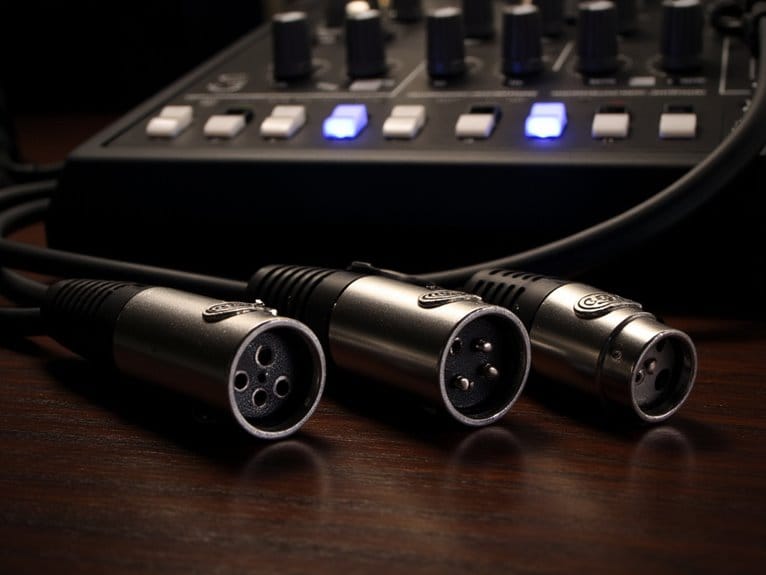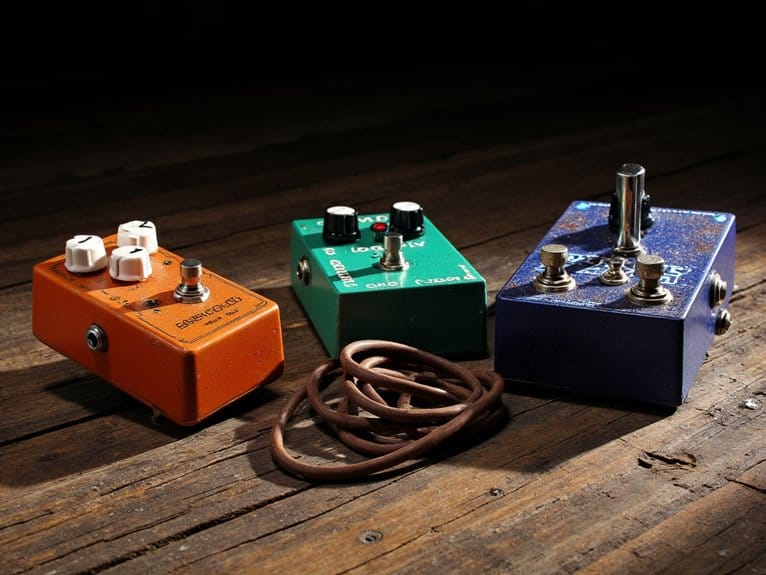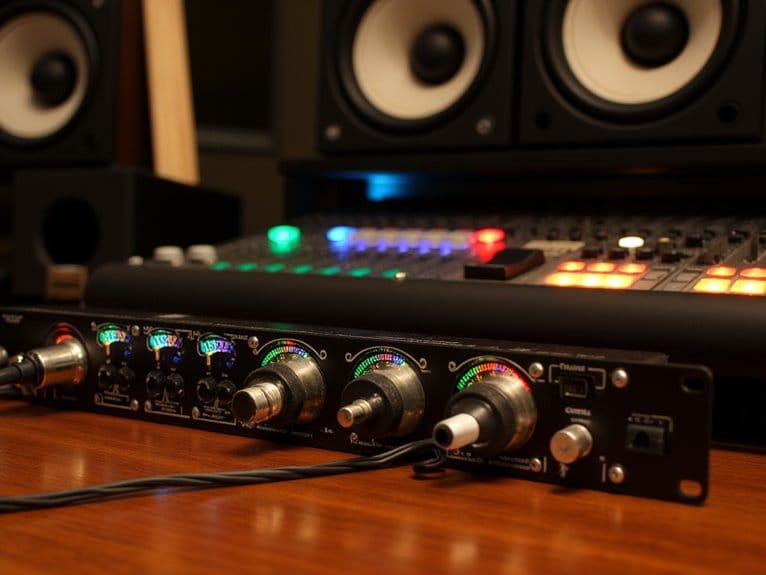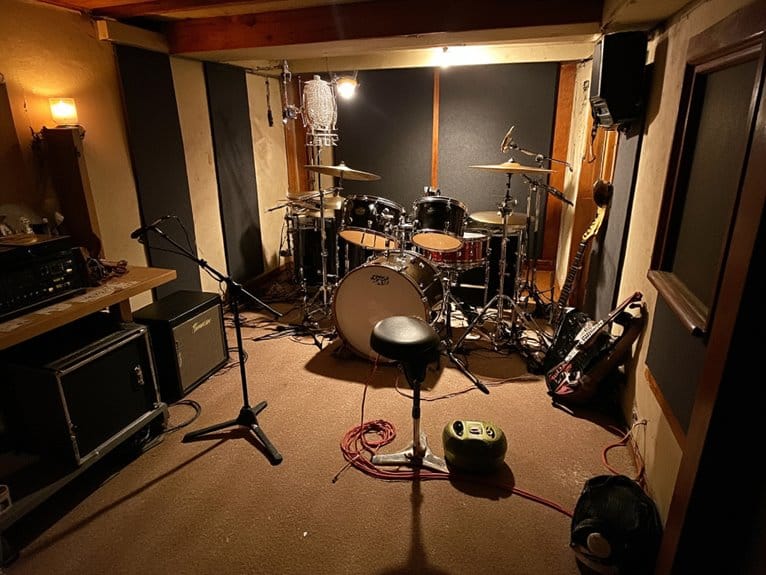Active vs. Passive Bass Electronics: Tone Shaping Options
Active bass electronics give you powered preamps with onboard EQ controls for precise frequency adjustment, letting you boost or cut specific ranges while maintaining strong signal integrity over long cable runs. Passive systems deliver raw, unprocessed pickup signals with wider dynamic range and natural response, though they lack tone-shaping flexibility and can suffer signal loss with lengthy cables. Your choice depends on whether you prioritize real-time tonal control or organic vintage warmth, and exploring these systems further reveals how each approach fundamentally transforms your playing experience.
We are supported by our audience. When you purchase through links on our site, we may earn an affiliate commission, at no extra cost for you. Learn more.
Notable Insights
- Active electronics provide onboard EQ controls with 2-4 band configurations for real-time frequency boosting and cutting.
- Passive electronics offer only frequency cutting through tone controls, delivering organic and unprocessed vintage warmth.
- Active systems maintain signal integrity over long cable runs with buffered outputs and reduced noise floors.
- Passive basses excel in natural dynamic range and responsiveness, ideal for blues and classic rock tones.
- Hybrid active/passive switching systems provide maximum versatility for adapting to different musical genres and situations.
Understanding Power Sources and Signal Amplification
When I first started exploring bass electronics years ago, I’ll admit the whole active versus passive debate seemed unnecessarily complicated, but understanding the fundamental differences in power sources and signal amplification quickly became the key to revealing better tone. Active pickups typically offer more consistent output and greater clarity, which can enhance overall tone quality. Additionally, many players find that the bass amp performance advantages of active systems, such as increased headroom and reduced noise levels, make them an appealing choice for live performances. Ultimately, the choice between active and passive setups often comes down to personal preference and the specific sound one hopes to achieve.
Active systems require onboard power, typically a 9V battery, to fuel preamps and EQ circuits that boost your signal before it reaches your amp. This creates low-impedance buffered outputs that maintain signal integrity over long cable runs, while proper impedance matching guarantees your tone stays crisp and clear.
Passive electronics skip the battery entirely, relying solely on pickup output and external amplification.
Modern Class D amplifiers offer exceptional power efficiency, reducing heat and extending battery life in active systems considerably.
Onboard EQ Controls and Frequency Adjustment
Although I’d been using active basses for months before really diving into their EQ capabilities, discovering how onboard frequency controls actually work transformed my understanding of what these instruments can accomplish tonally.
Active electronics provide remarkable EQ flexibility through 2-band, 3-band, or 4-band configurations that both boost and cut frequencies, while passive systems only cut specific frequency ranges.
You’ll find parametric mid controls on premium active basses allow selecting specific frequency bands for exceptional tonal precision, fundamentally putting amplifier-level tone shaping directly into your instrument.
Passive basses deliver more organic, dynamic response but sacrifice onboard adjustment capabilities. The copper wire wound around magnets in pickups generates the electrical signal through string movement, creating the foundation for both active and passive tone shaping.
Active preamps maintain signal strength over long cable runs, preventing the treble loss that plagues passive electronics, though they require battery power to function properly. The classic P-bass sound from precision basses demonstrates how effective passive electronics can be when paired with well-designed pickup configurations.
When using active electronics, understanding compression ratios becomes essential for managing the increased dynamic range and signal strength these systems provide.
Output Levels and Signal Quality Differences
Since discovering the dramatic difference in signal strength between my first active and passive basses, I’ve realized that output levels represent one of the most immediately noticeable distinctions between these two electronic systems. Active electronics deliver considerably higher output characteristics through their battery-powered preamps, while passive systems rely solely on pickup magnetism, creating substantial volume differences that affect your entire signal chain.
| Feature | Active Electronics | Passive Electronics |
|---|---|---|
| Output Level | High (preamp boosted) | Lower (pickup only) |
| Signal Integrity | Buffered, clean transmission | Susceptible to cable loss |
| Noise Performance | Reduced noise floor | Potential noise with long cables |
| Dynamic Range | Compressed response | Wider, natural dynamics |
The preamp buffering in active basses maintains signal integrity over longer cable runs, preventing the degradation that passive systems experience, though you’ll sacrifice some natural dynamic expression for consistency.
Choosing the Right Electronics for Your Musical Style
After years of switching between active and passive basses in different musical contexts, I’ve learned that your choice of electronics should align directly with the tonal demands and performance requirements of your primary musical style. For instance, if you frequently play in genres that emphasize punchy slap techniques or complex harmonics, opting for active electronics can provide the clarity and versatility needed. Additionally, exploring options like the short scale bass guitar can further enhance your sound while ensuring comfort and playability during long sessions. Ultimately, finding the right combination of electronics and instrument type can make a significant difference in your overall performance and enjoyment.
If you’re playing rock, jazz fusion, or pop where you need quick, precise tone adjustments and aggressive clarity, active electronics provide the style versatility you’ll crave. The onboard EQ lets you scoop mids for slap techniques or boost treble for cutting through dense mixes.
However, if your tonal preferences lean toward vintage warmth in blues, classic rock, or Motown, passive electronics deliver that organic, uncolored sound you’re after.
Passive electronics capture the pure, unprocessed tone that defines classic blues and Motown bass sounds.
Consider hybrid active/passive switching if you regularly perform across multiple genres.
On a final note
I’ve spent countless hours comparing these systems, and honestly, you can’t go wrong with either choice if it matches your playing style. Active electronics give you that crisp, controlled sound with extensive tonal flexibility, while passive setups deliver that warm, organic character many players crave. Your musical genre, gigging frequency, and personal preferences should ultimately guide your decision-both paths lead to great bass tone.

